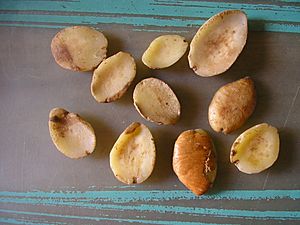Irvingia facts for kids
Quick facts for kids Irvingia |
|
|---|---|
 |
|
| Ogbono nuts | |
| Scientific classification |
|
| Kingdom: | Plantae |
| Clade: | Tracheophytes |
| Clade: | Angiosperms |
| Clade: | Eudicots |
| Clade: | Rosids |
| Order: | Malpighiales |
| Family: | Irvingiaceae |
| Genus: | Irvingia Hook.f. 1860 not F. Muell. 1865 (syn of Polyscias in Araliaceae) |
| Type species | |
| Irvingia smithii |
|
| Synonyms | |
|
Irvingella Tiegh. |
|
Irvingia is a group of trees found in Africa and Southeast Asia. You might know them by common names like wild mango, African mango, bush mango, dika, or ogbono. These trees grow delicious, mango-like fruits. People especially value them for their nuts, which are rich in healthy fats and protein.
The fruit is a large, fleshy fruit with a hard pit inside, much like a peach or a mango. The nuts inside are subtly fragrant. People usually dry them in the sun to keep them fresh for a long time. You can buy these nuts whole or as a powder. Sometimes, they are ground into a paste called dika bread or Gabon chocolate.
These nuts are very special because they contain a lot of mucilage. This slimy substance helps to thicken dishes, like the popular ogbono soup. You can also press the nuts to get vegetable oil. The wood from these trees is also very strong and useful for building things.
Contents
About Irvingia Trees
The Irvingia group of trees was first described in 1860. They naturally grow in parts of Africa and Southeast Asia. The name Irvingia was chosen to honor Edward George Irving, who was a surgeon in the Royal Navy.
Amazing Fruits and Nuts
The fruits of Irvingia trees are quite special. They are a type of fruit called a drupe, which means they have a fleshy outer part and a hard pit inside. The flesh of the fruit is fibrous.
The nuts from these fruits are very important. They are full of healthy fats and protein, making them a valuable food source. After harvesting, the nuts are often dried in the sun. This helps to preserve them so they can be stored and sold.
People use these nuts in many ways. They can be ground into a powder or a paste. This paste is sometimes called "dika bread" or "Gabon chocolate." One of the most common uses for the nuts is as a thickening agent. Because they contain a lot of mucilage, they can make soups and stews thicker and richer. A famous dish that uses these nuts is ogbono soup. The nuts can also be pressed to extract valuable vegetable oil.
Where Do They Grow?
Irvingia trees are native to two main regions:
- Africa: You can find them in West and Central Africa.
- Southeast Asia: They also grow in countries across Southeast Asia.
Different Kinds of Irvingia
There are several different types, or species, of Irvingia trees. Each species has its own specific areas where it grows best. Here are some of the known species:
- Irvingia excelsa grows in Central Africa.
- Irvingia gabonensis is found in West and Central Africa.
- Irvingia grandifolia also grows in Central Africa.
- Irvingia malayana is a species found in Southeast Asia.
- Irvingia robur grows in West and Central Africa.
- Irvingia smithii is found in West and Central Africa.
- Irvingia tenuinucleata also grows in West and Central Africa.
Images for kids
See also
 In Spanish: Irvingia para niños
In Spanish: Irvingia para niños





